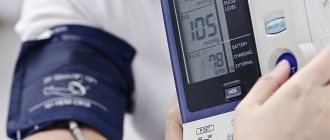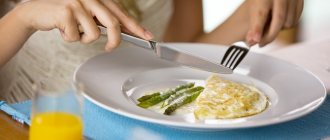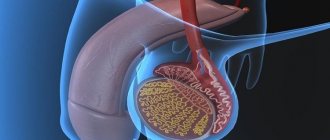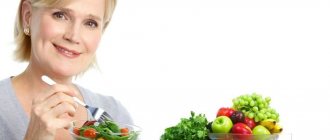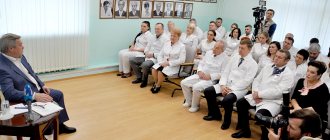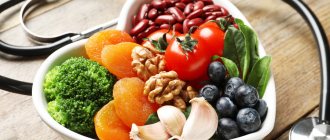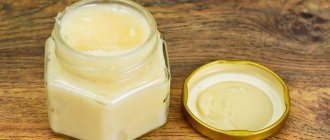Diet principles
- The foods consumed should contain a minimum amount of fat. Food containing animal fats must be completely excluded from the diet.
- The amount of salt used for cooking should be significantly reduced - no more than 5 g per day.
- You need to give up mayonnaise, margarine and butter.
- If you have heart problems, it is strictly forbidden to drink strong coffee and tea.
- The diet should be enriched with fruits, vegetables, and berries.
- It is useful to eat several times a day in fractional meals, consuming food in small portions.
- It is advisable to cook dishes by steaming or in the oven; fried foods should be avoided.
- The menu should be dominated by foods rich in polyunsaturated acids.
- Eating before bed is not recommended; dinner should be consumed 3 hours before rest.
The optimal amount of calories per day is no more than 2300 Cal.
A diet after cardiac stenting is prescribed to patients in order to eliminate disturbances in the body’s metabolic processes, improve blood circulation, lose excess weight, and provide a balanced diet without increased stress on the heart, kidneys, and liver. A healthy diet will help slow down the development of atherosclerosis and thereby prevent the progression of coronary heart disease.
Additional recommendations
Patients with cardiovascular problems should avoid alcoholic beverages. It has been proven that excessive alcohol consumption significantly increases the risk of developing cardiomyopathy, arterial hypertension, arrhythmia, and stroke. The maximum permissible daily alcohol intake is 100 ml of wine\30 ml of spirits. Smoking is strictly contraindicated. It puts a tremendous burden on all systems of the body, including the cardiovascular system. If you cannot quit cigarettes on your own, contact your doctor. He will help you choose the correct nicotine replacement therapy - patches, chewing gum, etc., thanks to which you will be able to give up your addiction without stressing the body.
Moderate physical activity plays an important role. You need to spend at least 30 minutes a day outdoors. Strength exercises are contraindicated for patients with cardiovascular problems. It is recommended to practice Nordic walking or swimming.
If after stenting or a heart attack you experience discomfort in the heart area, shortness of breath and other unpleasant symptoms, consult a doctor immediately.
Recommended Products
To lower the level of cholesterol in the blood and minimize the risk of developing atherosclerosis, ischemia and angina, it is necessary to include in the diet foods containing complex carbohydrates, fiber and polyunsaturated fatty acids. The daily menu should include:
- berries, vegetables and fruits;
- fresh herbs;
- dairy products;
- lean fish;
- seafood (seaweed, mussels);
- vegetable oil (olive or sunflower);
- poultry meat (chicken, turkey);
- lean meats (lamb, veal, lean beef);
- vegetable soups;
- cereal crops.
Decoctions of wheat bran and rose hips have a good effect on cardiac activity and blood circulation. Vegetable and berry juices are also useful.
Is it necessary to contact a nutritionist or can you create a diet yourself?
Cardiologists strongly recommend contacting nutritionists with appropriate qualifications, who will select a suitable diet for each patient individually. Each person's body is unique, and there is no universal diet. Moreover, many patients are convinced that the diet means serious restrictions and a very meager menu. A nutritionist will help you create a varied, nutritious diet so that proper nutrition does not cause discomfort.
Authorized Products
After myocardial infarction and coronary artery stenting, the daily menu must include:
- vegetables, fruits, berries;
- nuts, beans, greens;
- homemade fermented milk products;
- lean fish, seafood (seaweed, mussels, shrimp);
- unrefined vegetable oil (preferably olive, flaxseed);
- chicken, turkey;
- lean meat - veal, beef tenderloin;
- whole grain cereals.
Important! You should not buy low-fat fermented milk products. They are significantly inferior in taste, are repeatedly processed, and contain a lot of synthetic additives.
Prohibited Products
Men and women who have had a stent or heart attack should completely avoid:
- coffee, cocoa, chocolate, spices;
- fatty fermented milk products - cheese, sour cream, cream;
- fatty meat, fish;
- puff pastries;
- mushrooms and even mushroom broths;
- canned, smoked products;
- mayonnaise, margarine, butter.
It is also worth removing from the menu store-bought sauces, sausages, various chips, crackers, nuts and other products that are not recommended for consumption even by absolutely healthy people.
Foods to eat in moderation
The menu after stenting and heart attack may contain the following products, but in limited quantities:
- semolina, rice cereal;
- whole grain pasta, bran bread;
- honey, sugar;
- grapes, raisins, bananas.
This is a difficult food for the body, the consumption of which should be minimized.
Prohibited Products
After stenting surgery, patients should completely limit their consumption of the following foods:
- coffee;
- cocoa;
- spices;
- chocolate;
- dairy products with high fat content (cream, sour cream, etc.);
- fatty meats (beef, pork);
- fatty fish (sardines, sprats, etc.);
- products made from puff pastry and butter dough;
- meat, mushroom, fish broths;
- canned and smoked foods;
- mayonnaise, margarine, butter.
Figures and facts
People who have had a heart attack have a higher risk of new cardiovascular events than those who have a healthy heart. Lifestyle changes can significantly reduce your risk. According to statistics, effective prevention of recurrent cardiovascular events through lifestyle changes saves 80,000 lives per year in the United States alone!
According to research, quitting smoking, regular physical activity and diet correction reduce mortality by 20-35%. However, despite such a powerful preventive effect, not all people are in a hurry to switch to a special diet after a myocardial infarction. It is known that only 43.4% of patients with cardiovascular diseases in high-income countries and 25.8% in low-income countries adhere to the principles of a healthy diet. Even after receiving full information about the importance of diet correction and the basic requirements for changing it, many patients simply reduce the caloric content of foods and continue to eat incorrectly. At the same time, the principles of healthy eating are simple both to understand and to implement.
Exercise therapy after a heart attack
Physical exercise has undoubted benefits during rehabilitation. Regular exercise helps strengthen the muscle tissue of the heart, normalizes the functioning of the nervous system and relieves depression.
Thanks to moderate loads, scarring of the consequences after a heart attack is accelerated. Also, exercise therapy is necessary if the patient is overweight.
Important
! You cannot independently assign a load level based on your own feelings. The increase should occur gradually under the close supervision of a professional trainer or attending physician.
| Stage | Location | Days | Load volume |
| 1 | Intensive therapy | 1 | Strict bed rest Turning in bed Raising the head of the bed for no more than 10 minutes 1–3 times a day |
| 2–3 | Sit in bed and (or) chair for up to 20 minutes 1-3 times Eat while sitting Start physical therapy classes under the supervision of an instructor for no more than 5 minutes | ||
| 4–7 | Get up and walk next to the bed 2-3 times a day Exercise therapy (physical therapy) up to 10 minutes a day | ||
| Cardiology | 8–10 | Sitting in a chair and/or bed all day Going to the toilet in a wheelchair Walk around the bed and around the ward - gradually increasing the number of minutes Perform physical therapy for 10–15 minutes | |
| From 10 | Leaving the room Increase the load on your well-being, walking from 50 to 500 meters daily, with rest breaks Do therapeutic exercises for up to 20–30 minutes twice a day | ||
| 2 | Cardiac rehabilitation center or sanatorium | 14–28 | Do exercises on cardio equipment (treadmill, bicycle ergometer) with a gradual increase in intensity and time Do moderate walking in the fresh air Perform sets of therapeutic exercises for 40–60 minutes 2 times a day |
| 3 | Home + physical education and treatment center | From 29 | Dosed walks in the fresh air up to 3.5 km 3 times a week, at the initial stage - with rest and at a slow pace Climbing flights of stairs up to the 3rd–5th floor, also with breaks 1–2 times a week (does not replace walking!), starting with a slow step up 1 step in 3–4 s Exercises on exercise machines that train the heart muscle, 20-30 minutes a day (at home or in a specialized center) |
Physical therapy for this pathology leads to the following effects:
- Strengthening the heart muscles;
- Stimulating better blood flow through the vessels;
- Reducing cholesterol;
- Reducing the possibility of developing atherosclerosis;
- Increased ability of the heart to contract;
- Makes blood vessels more elastic;
- Rehabilitation reduces the risk of thrombosis.
Recovery stages
Rehabilitation after myocardial infarction is divided into several gradual stages:
- Surgery for blood clots that need to be removed;
- Achieving the standard of living of patients that was before the disease;
- Diagnosis of the heart and blood vessels, as well as gradual prevention to improve their condition;
- Carrying out therapy with medications;
- Changing the entire lifestyle, including a special diet, exercise, increasing rest time;
- Slow but consistent return to working capacity and normal routine.
Rehabilitation can be carried out not only in clinics and rehabilitation centers, but after discharge from the hospital.
You should start with restoring the physical functions of the body:
- Since after the onset of the pathology the patient was forced to stay in bed for a long time, rehabilitation can begin simply by turning over from one side to the other;
- After 2 days , you are allowed to sit down and relieve yourself while sitting, and the time spent in a sitting position should not exceed 10 minutes ;
- Then the period should be gradually increased, sitting on the bed for up to half an hour;
- The next exercise can be considered trying to get up and walk around the room for a while;
- After a week, you can do a simple warm-up and remain in a sitting position for an unlimited amount of time;
- Next you need to walk up the stairs every day, if possible;
- Then it is allowed and recommended to walk at a leisurely pace. At first, about half a kilometer a day, gradually increasing the distance to 1500 meters , and you need to walk along a road that does not have differences in altitude.
You can use the table below to understand when and what you can do.
| Degree | Sick day | Mode | Permitted loads |
| 1A | 1st | Strict bed | The patient is in a supine position. Special exercises from exercise therapy are prohibited. He can only turn on his right side and eat food on his own. |
| 1B – 2A | From 2nd to 3rd | Bed extended | The patient can independently turn and sit up in bed, initially with the help of medical staff, and then independently. Later you can move to a chair. Exercises are allowed in a supine position, which are performed for 8-10 minutes. Breathing should be static. After each exercise you need to take a break. The pulse should not exceed 20 beats per minute. |
| 2B – 3A | From 4th to 14th | Ward strict | The patient can already walk around the ward and corridor at a distance of 20 to 200 m. Exercises performed in a sitting position are already allowed. The pace is slow or medium. |
| 3B | From 14th to 21st | Ward extended | The patient is already allowed to walk along the corridor without restrictions. Exercises are performed in standing and sitting positions, and can be either individual or group. |
| 4A and 4B (classes I, II, III and IV) | From the 21st | Free | Walking is acceptable, and the step speed is average - from 70 to 100 steps per minute. A set of exercises is performed in a sitting and standing position. |
Contraindications and restrictions
Contraindications for exercise therapy during rehabilitation after stenting of the coronary arteries are calculated individually for each patient, which are divided into 4 classes :
- Patients with pathologies of the heart muscle, but who do not require special restrictions. During the usual pace of life and activity, fatigue and shortness of breath do not appear. Therefore, they are recommended to: run, briskly walk, climb stairs and lift weights up to 15 kg .
- Patients with minor limitations in physical activity. In patients of this class, there is no change in parameters in a calm state, but slight dizziness and rapid heartbeat appear. Therefore, a special lightweight program is being developed: moderate running, walking at an average pace, lifting weights up to 10 kg and walking up the stairs to a maximum of the 5th floor .
- The condition is assessed as satisfactory, but gymnastics is permissible in a reduced amount, since the condition sharply worsens when moving. It is allowed to walk up to 90-120 steps per minute, climb stairs to the 3rd floor and carry no more than 3 kg .
- The load during rehabilitation after stenting of the carotid artery is minimized. Patients are allowed to walk at a slow, measured pace, stopping frequently to catch their breath.
Therapeutic exercises have a unique value during recovery. However, how long the rehabilitation period will take depends on compliance with all the doctor’s recommendations. But there are also a number of strict prohibitions on exercise therapy:
- fever;
- negative change in ECG indicators;
- cardiogenic shock;
- intense pain in the heart muscle;
- heart rhythm disturbances resistant to drug therapy;
- swelling of the lung tissue, pneumonia;
- poor blood circulation and increased heart rate at rest (more than 105 beats per minute).
Other indicators not related to the surgery should also be taken into account when determining prohibitions. For example, brain problems or other head injuries are one of the most serious contraindications to exercise therapy during rehabilitation after cardiac stenting.
Rehabilitation after a planned awning requires time and patience. The vessels are still weak and there is a high risk of a second attack, so doctors’ prohibitions must be taken seriously!
There are a number of contraindications to physical activity after a heart attack. These include serious heart complications:
- cardiac aneurysm;
- arrhythmia;
- heart failure.
The main contraindication is excessive physical and mental stress on the heart and the entire body as a whole. The patient needs to be kept at rest and in a supine position.
When doing gymnastics, you may experience shortness of breath, wheezing, mild heart pain and panic attacks. If your readings are normal, you should not be alarmed by these symptoms. But to be sure, you definitely need to track:
- heart rate;
- arterial pressure;
- ECG.
Attention
! If there is shortness of breath, it is necessary to keep the patient elevated so that the person does not suffocate.
It is undesirable to work in garden plots for a long time after an attack, especially in hot weather, in order to prevent overload of the heart muscle.
If the patient has heart failure or is in a state of shock, then he cannot be transported over long distances.
You need to be careful when taking medications; they should only be prescribed by a doctor, after having done all the tests and examined the patient first.
Physical therapy, including intense exercise, is also contraindicated during a heart attack. Rehabilitation is prohibited when the presence of arrhythmia, high body temperature, more than 38 degrees , as well as low blood pressure and heart failure are detected.
After discharge from the hospital, gradual additional rehabilitation is simply necessary to more quickly restore the functionality of the body and return to a normal lifestyle.
There are practically no contraindications for exercise therapy in the event of a myocardial infarction; you just need to follow simple recommendations:
- During an exacerbation of the disease, it is prohibited to perform actions that cause physical activity;
- After at least 72 hours , you must obtain a doctor's permission to conduct classes.
If negative symptoms are detected, as well as due to the unpredictability of the consequences, you should immediately and without hesitation call an ambulance.
Exercise therapy rules
When prescribing exercise therapy, you should follow all the recommendations of the treating doctor:
- There is no need to increase the amount of active actions, even if you feel great;
- It is necessary to stop exercising if you feel worse after exercise. If after some time there is no improvement, then the use of medications is suggested for the normal operation of the product;
- Exercise therapy is used only after meals. But it is not recommended to perform tasks immediately after eating, so as not to overload the body! It is recommended to perform exercises 3-4 hours after eating.
- To prevent a rush of blood to the head, you should not bend below the level of your heart;
- Do not use force.
Complex No. 1
There are several particularly effective exercises that affect the condition during rehabilitation after a heart attack. Each of them starts with a standard position of hands, feet shoulder-width apart:
- You need to raise your arms above your head with your palms facing you, taking a deep breath, stretch and on a long exhale you need to lower your arms. Five to fifteen repetitions are required.
- You should place your hands on your hips and make up to seven turns of your torso. It is important not to lift your feet off the floor.
- The previous exercise can also be performed with your arms out to the side.
- It is necessary to bend back and forth without bending your knees. You should not bend over extremely deeply.
- It is recommended to do squats with your hands on your hips. At first, you can squat while leaning on a wall or chair.
- Leg stretching exercises will also be helpful. First, knees to arms bent 90 degrees. Then toes towards outstretched palms.
It is also recommended to start and end workouts by walking in place to warm up during rehabilitation. Classes must be held regularly at the same time, the duration of which should be from 30 minutes to 1 hour .
Complex No. 2
You can see examples of exercises below.
Important
! You should consult your physician before performing any exercise!
Complex No. 3
Complex No. 4
- In a standing position, the patient places his feet shoulder-width apart, while he extends his arms along the body. Having taken the correct position, you need to point your arms up and pull yourself up, while inhaling. At the next stage, the person exhales, lowering his arms and describing a circle. The number of repetitions is from 4 to 6 times .
- The next exercise is also performed standing. The toes should be spread apart and the hands should be placed on the belt. Next, you need to turn to the left and spread your arms to the sides while inhaling. Afterwards, exhale returning to the original position. In the same way, you need to make the required number of approaches by turning to the right. The number of repetitions is from 4 to 6 times .
- Having taken a vertical position, the arms are fixed along the body, and the legs are placed shoulder width apart. Inhalation is performed. Then the person squats and bends forward slightly, moving his arms in the opposite direction and exhaling. The number of repetitions is from 4 to 6 times .
- The patient is in the same starting position as in the previous exercise. Exhales deeply, the person places his hands on the thighs and squats. Then, when returning to the original position, inhale. The number of repetitions is from 3 to 4 times .
- The patient will need a chair. He should sit down leaning on the back, grab the seat and stretch his legs - this is the starting position. Next, you will need to bend your head back and inhale. Afterwards, return to the previous position by exhaling. The number of repetitions is from 3 to 4 times .
Complex No. 5
Complex No. 6
- Breathing using the diaphragm (see below). Apply 4 times;
- Sharp clenching and unclenching of fingers into a fist. Apply 10 times for both hands;
- Perform rotational movements for each of the feet. Apply 5 times;
- Bend the arms at the elbow joint. Apply 4 times for each hand;
- Raising the pelvis. The exercise is done with an assistant. Apply 3 times;
- This is followed by a short break necessary to restore breathing and heart rate;
- For the next exercise, you need to bend your legs at the knee joint, while your feet should remain on the bed. The patient slowly brings and spreads his knees. Apply 5 times;
- The outstretched arm is first slowly moved to the side, and then returned to the starting position. Apply 4 times for each hand.
- With the support of an assistant, turns on your side in each direction are performed. Apply 3 times;
- Rotation of the hands. Apply 5 times.
Complex No. 7
It is recommended to do a short warm-up before gymnastics in the form of 5-10 minutes of walking in place. This will protect you from sprains and other possible injuries. It also strengthens the blood vessels of the lower extremities.
- Walk in place for 10 minutes .
- You need to sit on a chair without leaning on the back, your posture is straight. Bring your legs together, arms down. Alternately raise your arms up as you inhale, and lower them again as you exhale. Repeat the exercise 5 times .
- Press your hands to your shoulders, raise them slightly above your chest and make parallel circular movements. First, it takes 5 times in a circular arrow, then the same number against it.
- Connect your legs, spread your arms to the sides. As you inhale, pull your knee as close to your chest as possible, helping with your hands. As you exhale, smoothly return to the starting position. Perform 3 to 5 repetitions with each leg.
- Next, you should stand with your feet shoulder-width apart and your arms outstretched. As you inhale, you need to raise your arms up and, bending over, try to reach your toes with your fingers. As you exhale, return to the starting position.
- Place your hands on your waist and perform side bends, 5 times in each direction.
- Standing, feet together, hands at your sides. As you inhale, move your right arm and leg to the side and hold it there for a few seconds. As you exhale, gently lower your limbs. If possible, repeat up to 5 times on each side.
- Walk in place for 15-30 minutes .
Complex sitting
Complex for bedridden patients
Often, with severe lesions, it is necessary to perform exercise therapy for permanently bedridden patients. The set of actions includes the following procedures:
- You need to clench and straighten your fist about 10 times;
- Make circular movements with your feet;
- Bend your legs and arms at the elbows;
- A more complex exercise, performed only with the help of a specialist.
Finger exercises
Doctors often do not prohibit doing finger exercises. Example exercises could be:
Additional exercises
Each specialist uses his own gymnastic technique and set of exercises to train the body after myocardial infarction. Let's consider one of them:
- Standing, spread your legs to shoulder level. Then raise your hands and take a deep breath. As you exhale, lower your limbs in an arc. Repeat 5 times;
- Place your hands on your waist and place your heels together. Turn in different directions, periodically changing inhalation to exhalation. The number of approaches is also 5 times;
- Your arms should be extended along your body, your feet should be shoulder-width apart. Inhale and squat, leaning forward and exhaling.
- Exercise using a chair. You need to sit on it, grab the seats with your hands and straighten your legs. To relax, it is recommended to bend over and throw your head back.
How is such an operation as stenting performed?
To restore blood flow, a stent, which is a metal frame, is inserted through an artery in the thigh or arm to the site of blockage. It is opened using a special balloon and left in the vessel. As a result of this operation, blood flow is stabilized. If surgery is not performed, there is a risk of developing a heart attack—the death of heart tissue.
But the problem cannot be solved with one operation - after its implementation, in order to reduce the load on the heart, it is necessary to adhere to a diet.
Secrets of cooking healthy food3
A healthy diet is not just about lots of fruits, vegetables, fish and whole grains. This is also the correct heat treatment of dishes, which allows you to preserve the beneficial properties of the products.
How to fry correctly?
- Instead of frying the meat in a pan, it is better to wrap the meat in foil and bake in the oven or grill. It is better to do the same with fish and poultry.
- For frying, you should use sunflower and olive oil. To reduce the amount of oil soaked in food, use a non-stick frying pan.
- It is important to trim the fat from meat before cooking.
How to stew correctly?
- Use minimal salt.
- Refrigerate food immediately after cooking. The fat will harden on the surface, after which it can be removed.
What products are better to choose?
- Use low-fat lactic acid products and natural sugar-free yogurt
- Replace sour cream or mayonnaise with reduced-fat cottage cheese or natural low-fat yogurt
- Give preference to low-fat cheeses
- Use olive and other vegetable oils instead of cooking fats
- Choose lean meat and poultry without skin.
Select equipment
Strong coffee, tea, and chocolate are excluded from drinks. Caffeine constricts blood vessels, leading to arrhythmia and excessive heart work. Excessive load on the organ is dangerous for patients with coronary heart disease.
How coffee affects the body
Coffee is a drink that affects the nervous system. A healthy person is recommended no more than 0.3 g of caffeine per day, which corresponds to 3 tsp. ground coffee. The drink can be drunk in the first half of the day. It is better not to consume it after lunch so as not to disturb your sleep.
Coffee dilates blood vessels, increases blood flow, and accelerates biochemical processes. The transmission of nerve impulses improves, the person feels cheerful. But if you have high stomach acidity, coffee is contraindicated. It stimulates digestion, increases appetite, and if you are overweight, this is undesirable.
Coffee has a diuretic effect. After a cup of drink, you need to replenish the lack of fluid in the body. When dehydrated, blood viscosity increases, which leads to blood clots.
Coffee is contraindicated after stenting. It all depends on the specific organism. You can limit yourself to a cup of light drink in the morning. But if you feel discomfort after taking the drink, it is better not to risk it and refuse it.
Work after valve replacement
Within a few weeks after surgery, patients usually manage to restore their ability to work at their previous level. In some cases, a transition to easier working conditions is required. Sometimes patients are given a disability group.
The above formulations are quite streamlined, but it is impossible to give specific figures here. Much depends on which valve was prosthetized, what type of artificial valve was, in connection with what disease the operation was performed, and in what field the person is employed.
In general, the forecast for work activity is favorable. Even professional athletes returned to sports after this surgical intervention and successfully continued their careers.
Fully or partially limited products
All types of fatty meat, bacon, lard, any sausages, pates and meat pastes, as well as offal - liver, heart, brains - should be excluded from the diet. Broths containing meat, mushrooms and fish are prohibited. All fried foods, animal and cooking fats, mayonnaise and margarine are completely excluded from the diet. The consumption of butter, high-fat dairy products (sour cream, cream), and cheese is limited. Consumption of chicken eggs is limited to 3-4 eggs per week. You should not include fish and crustacean caviar, fatty fish (sprats, sardines) in your diet.
From the list of products you need to cross out white bread, confectionery, ice cream, carbonated drinks, as well as sugar and products containing it, honey. It is recommended to replace sweets with dried fruits. The restriction also applies to products with a high salt content (pickles, canned food, smoked meats). After vascular surgery, the consumption of chicken egg yolks, products made from butter/puff pastry, rice, semolina, pasta, as well as products containing a lot of caffeine (chocolate, strong tea, coffee, cocoa), which cause vasospasm and increase heart disease, is completely prohibited. activity. The consumption of sweet carbonated drinks, raisins, grapes, various spices and all types of alcoholic drinks is not allowed.
Table of prohibited products
| Proteins, g | Fats, g | Carbohydrates, g | Calories, kcal | |
Fruits | ||||
| bananas | 1,5 | 0,2 | 21,8 | 95 |
Berries | ||||
| grape | 0,6 | 0,2 | 16,8 | 65 |
Nuts and dried fruits | ||||
| raisin | 2,9 | 0,6 | 66,0 | 264 |
Cereals and porridges | ||||
| semolina | 10,3 | 1,0 | 73,3 | 328 |
| white rice | 6,7 | 0,7 | 78,9 | 344 |
Flour and pasta | ||||
| pasta | 10,4 | 1,1 | 69,7 | 337 |
Bakery products | ||||
| bagels | 16,0 | 1,0 | 70,0 | 336 |
| bagels | 16,0 | 1,0 | 70,0 | 336 |
| crackers | 11,2 | 1,4 | 72,2 | 331 |
Confectionery | ||||
| jam | 0,3 | 0,2 | 63,0 | 263 |
| jam | 0,3 | 0,1 | 56,0 | 238 |
| candies | 4,3 | 19,8 | 67,5 | 453 |
| pastry cream | 0,2 | 26,0 | 16,5 | 300 |
Ice cream | ||||
| ice cream | 3,7 | 6,9 | 22,1 | 189 |
Cakes | ||||
| cake | 4,4 | 23,4 | 45,2 | 407 |
Chocolate | ||||
| chocolate | 5,4 | 35,3 | 56,5 | 544 |
Raw materials and seasonings | ||||
| ketchup | 1,8 | 1,0 | 22,2 | 93 |
| mayonnaise | 2,4 | 67,0 | 3,9 | 627 |
| honey | 0,8 | 0,0 | 81,5 | 329 |
Dairy | ||||
| cream | 2,8 | 20,0 | 3,7 | 205 |
| sour cream 30% | 2,4 | 30,0 | 3,1 | 294 |
| sour cream 40% (fat) | 2,4 | 40,0 | 2,6 | 381 |
Cheeses and cottage cheese | ||||
| cheese | 24,1 | 29,5 | 0,3 | 363 |
| cottage cheese 18% (fat) | 14,0 | 18,0 | 2,8 | 232 |
Meat products | ||||
| pork | 16,0 | 21,6 | 0,0 | 259 |
| pork liver | 18,8 | 3,6 | 0,0 | 108 |
| pork kidneys | 13,0 | 3,1 | 0,0 | 80 |
| pork fat | 1,4 | 92,8 | 0,0 | 841 |
| salo | 2,4 | 89,0 | 0,0 | 797 |
| beef liver | 17,4 | 3,1 | 0,0 | 98 |
| beef kidneys | 12,5 | 1,8 | 0,0 | 66 |
| beef brains | 9,5 | 9,5 | 0,0 | 124 |
| mutton | 15,6 | 16,3 | 0,0 | 209 |
Sausages | ||||
| smoked sausage | 16,2 | 44,6 | 0,0 | 466 |
| smoked sausage | 9,9 | 63,2 | 0,3 | 608 |
| sausages | 10,1 | 31,6 | 1,9 | 332 |
| sausages | 12,3 | 25,3 | 0,0 | 277 |
Bird | ||||
| smoked chicken | 27,5 | 8,2 | 0,0 | 184 |
| duck | 16,5 | 61,2 | 0,0 | 346 |
| smoked duck | 19,0 | 28,4 | 0,0 | 337 |
| goose | 16,1 | 33,3 | 0,0 | 364 |
Eggs | ||||
| chicken eggs (yolk) | 16,2 | 31,2 | 1,0 | 352 |
Fish and seafood | ||||
| smoked fish | 26,8 | 9,9 | 0,0 | 196 |
| salted fish | 19,2 | 2,0 | 0,0 | 190 |
| Red caviar | 32,0 | 15,0 | 0,0 | 263 |
| black caviar | 28,0 | 9,7 | 0,0 | 203 |
| squid | 21,2 | 2,8 | 2,0 | 122 |
| salmon | 19,8 | 6,3 | 0,0 | 142 |
| sturgeon | 16,4 | 10,9 | 0,0 | 163 |
| canned fish | 17,5 | 2,0 | 0,0 | 88 |
| semi-finished fish products | 12,5 | 6,7 | 14,7 | 209 |
| sardine | 20,6 | 9,6 | — | 169 |
| mackerel | 18,0 | 13,2 | 0,0 | 191 |
| cod (liver in oil) | 4,2 | 65,7 | 1,2 | 613 |
Oils and fats | ||||
| butter | 0,5 | 82,5 | 0,8 | 748 |
| creamy margarine | 0,5 | 82,0 | 0,0 | 745 |
| coconut oil | 0,0 | 99,9 | 0,0 | 899 |
| palm oil | 0,0 | 99,9 | 0,0 | 899 |
| rendered beef fat | 0,0 | 99,7 | 0,0 | 897 |
| cooking fat | 0,0 | 99,7 | 0,0 | 897 |
| rendered pork fat | 0,0 | 99,6 | 0,0 | 896 |
Alcoholic drinks | ||||
| white dessert wine 16% | 0,5 | 0,0 | 16,0 | 153 |
| dry white wine | 0,1 | 0,0 | 0,6 | 66 |
| vodka | 0,0 | 0,0 | 0,1 | 235 |
| cognac | 0,0 | 0,0 | 0,1 | 239 |
| liquor | 0,3 | 1,1 | 17,2 | 242 |
| beer | 0,3 | 0,0 | 4,6 | 42 |
Non-alcoholic drinks | ||||
| cola | 0,0 | 0,0 | 10,4 | 42 |
| black coffee | 0,2 | 0,0 | 0,3 | 2 |
| Pepsi | 0,0 | 0,0 | 8,7 | 38 |
| sprite | 0,1 | 0,0 | 7,0 | 29 |
| tonic | 0,0 | 0,0 | 8,3 | 34 |
| black tea | 20,0 | 5,1 | 6,9 | 152 |
| * data is per 100 g of product | ||||
Sample menu (breakfast, lunch, dinner)
During rehabilitation, the menu should be built according to the so-called ration number. Each of them corresponds to the period after the intervention. Depending on the time period, there are:
- Diet 1. Nutrition in the first week after surgery. At this time, the patient is shown complete rest. Dishes should be pureed and unsalted. The patient is fed up to 6 times a day in small portions. Prohibited products are necessarily excluded.
- Diet 2. Corresponds to weeks 2 and 3 after the intervention. The food is not ground, but crushed to create a dosed load on the digestive organs. Small and frequent feeding continues.
- Diet 3. During the period of scarring, it is important to activate the digestive organs in a normal manner. The diet involves a return to a varied diet.
The menu is based on the principles of table No. 10 of the therapeutic diet according to Pevzner, intended for people who have suffered a myocardial infarction. Here is an example of a daily menu for each diet.
Diet 1
| Breakfast | Hercules porridge with milk, curd paste, tea with milk |
| Lunch | Applesauce |
| Dinner | Soup with vegetables and semolina, meat soufflé, carrot puree, fruit jelly |
| Afternoon snack | Pasta with cottage cheese, rosehip decoction |
| Dinner | Steamed fish meatballs, boiled grated buckwheat, tea |
| For the night | Prune decoction |
Diet 2
| Breakfast | Egg white omelette, semolina porridge with fruit puree, tea with milk |
| Lunch | Cottage cheese paste with rosehip decoction |
| Dinner | Vegetarian borscht with boiled meat, mashed potatoes, fruit jelly |
| Afternoon snack | Baked apples |
| Dinner | Boiled fish, carrot puree, tea with lemon |
| For the night | kefir |
Diet 3
| Breakfast | Cheese, buckwheat porridge, tea with milk |
| Lunch | Curd and milk mixture, rosehip decoction |
| Dinner | Oatmeal soup with vegetables, boiled chicken, stewed beets with sour cream, apples |
| Afternoon snack | Baked apples |
| Dinner | Boiled fish, mashed potatoes, tea with lemon |
| For the night | kefir |
Diet after stenting can save the patient’s life. Follow the recommendations for nutrition and lifestyle, and the disease will recede.
Author: Shirokhova Natalya Pulmonologist, immunologist, allergist

